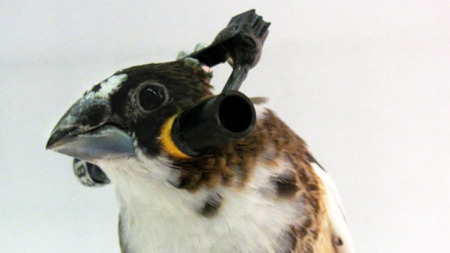
“Did Google Kill this Donkey?” asks Jalopnik. The answer is no:“Because of the way our 360-degree imagery is put together, it looked to some that our car had been involved in an unseemly hit and run, leaving the humble beast stranded in the road.
As our imagery below shows, the donkey was lying in the path - perhaps enjoying a dust bath - before moving safely aside as our car drove past. I’m pleased to confirm the donkey is alive and well.”
Read More“We live in a time when the loneliest place in any debate is the middle, and the argument over technology’s role in our future is no exception. The relentless onslaught of novelties technological and otherwise is tilting individuals and institutions alike towards becoming Engineers or Druids. It is a pressure we must resist, for to be either a Druid or an Engineer is to be a fool. Druids can’t revive the past, and Engineers cannot build technologies that do not carry hidden trouble.”
- “The Coming Fight Between Engineers And Druids” by Paul Saffo, in Edge: What should be we worried about?.
Read More

From Regine Debatty’s review of Bad Graffiti by Scott Hocking.
Why do I blog this? I’m fascinated by bad art/naive production and the sort of effect they produce. When it comes to graffiti, I’ve always been intrigued by the way ugly throw-ups, bad drawings and paint stains form a curious urban texture.
Read MoreSarif Industries trailer (ad for Deus Ex, a video game)
Read More
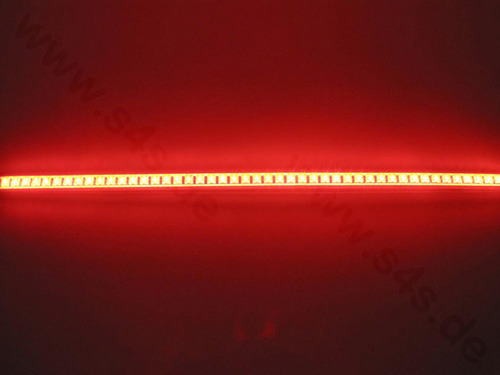
Knight Rider’s red light interface. According to the Wikipedia:
KITT’s scanner is similar to that of Cylons from the science fiction series Battlestar Galactica. Glen A. Larson, the creator of both Knight Rider and Battlestar Galactica has stated that the two shows have nothing else in common and to remove any fan speculation, he stated in the Season One Knight Rider DVD audio-comments, that he simply reused the scanning light for KITT because he liked the effect.
Why do I blog this? I’m currently in a seminar with design students and we are discussing interface from science-fiction pieces, their meaning and their implications. This example popped out as relevant.
Read More
“Where did the Future Go?” by Alice Framis.
Read More““… design-fiction comes with the history of conceptual design. Despite its name, it has nothing in common with conceptual art. It is a parallel design activity which is not attained through production and which can be associated with the experiences of the Radical Italians in the 1960s, for example. This way of thinking occurs every time a group of designers are no longer satisfied by industrial production and its poverty of intellect. The path of ‘design-fiction’ allows one to be a designer differently by pursuing a parallel path.””
- Antony Dunne, interviewed by Alexandra Midal, in “Tomorrow Now - When Design Meets Science-Fiction” (2007)
Read More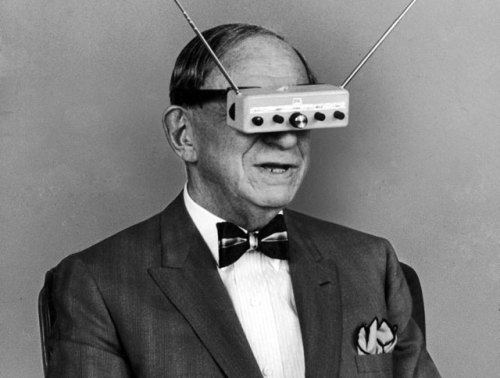
“Hugo Gernsback wearing his TV Glasses in 1963 Life magazine shoot.”
Read More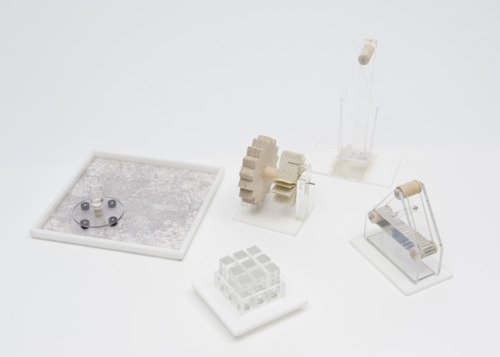
(via Stefano Mirti), as reported by Dezeen
Royal College of Art student Gabriele Meldaikyte has designed a set of interactive exhibits for a museum of iPhone gestures. “There are five multi-touch gestures forming the language we use between our fingers and iPhone screens,” says Meldaikyte. “This is the way we communicate, navigate and give commands to our iPhones.”. She used wood and acrylic to make five 3D objects that recreate the physical actions required to operate a touch-screen smartphone, using newspaper clippings, book pages and paper maps to represent the data being manipulated.
Why do I blog this? An interesting design research approach to highlight new interaction rituals. Surely a good complement to our curious ritual project with a more tangible format.
Read More
(via Pop-Up Urbain ) Do Computers Dream of Electronic Sheep ? (2013) Directed by Benjamin Bardou Produced by Data Films Music composed by Steve Moore - Logos from “The Way In” album (1990 - Inner Ear Recordings) CGI from the videogame GTA IV (Rockstar Games/Take Two Interactive) Data Films - 2013
Why do I blog this? This is a fantastic depiction of computing with urban inserts from GTA. What is fascinating here is the way the different visuals create a new form of aesthetic, an alternative near-future world that merges past and present representations.
Read MoreStar Wars map by Andrew DeGraff.
Read More: Tbh I find this whole url culture Tumblr’s formed to be less annoying...:
cokekitty:
Tbh I find this whole url culture Tumblr’s formed to be less annoying and more interesting. Like it’s just totally mind-blowing and genuinely fascinating to me that urls have developed their own barter system in the Tumblr community. People hunt down urls and keep them to themselves, and trade them for urls of “equal or greater value”. What determines value for a url? On what scale is it being measured, if any? Do people with lots of hoarded urls have more value on Tumblr than people like me who only have the one(s) I use right now? This is really cool I’m kind of excited I’ve finally got a window into this Tumblr black market, I’ve always had glimpses at it before but this is the first time I’ve ever really gotten into the nitty gritty of how it works.
Why do I blog this? Yesterday I found this term “URL culture” while browsing and I find it clearly encapsulates something intriguing about our current culture. “hoarded URL”, that sounds great.
Read More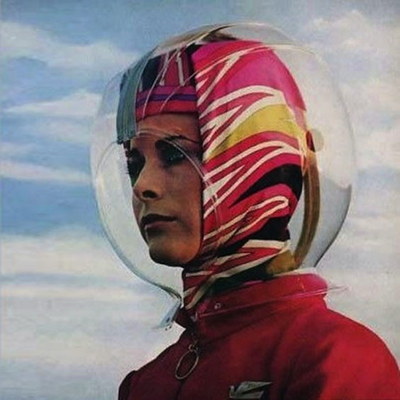
The Bubble Bonnet, aka the Space Bubble Helmet:
In 1964, Braniff airlines was looking for a way to differentiate itself from its competitors by adding a touch of glamour and weirdness to its service. So it hired Italian fashion designer Emilio Pucci to design the uniforms of the stewardesses. What he came up with was the plexiglass Bubble Bonnet, aka the Space Bubble Helmet. Its purpose was supposedly to protect the hair of the stewardesses from wind and rain as they crossed the tarmac. Stewardesses complained that it was hard to hear anyone while wearing the things.
Why do I blog this? It looks rather retro-futuristic now but I guess the designer was sincere at the time. A too heavy future though.
Read More

Mindloop by One Life Remains:
This game is controlled by a mental brain wave thingy. Each color is associated with a brain activity type (Focus, relax, …). You need to be in that state to make the cube come back on the road. The road is the inside of a cylinder so the track is never-ending. The tricky part here is that if you manage to go through the first time doesn’t mean you can do it again easily. And it’s brain tiring
Why do I blog this? Next month I’m going to give a speech in Boston at the AAAS conference about the design issues related to brain-computer interfaces. This game is a good example to introduce some of the concepts I want to address there.
Read More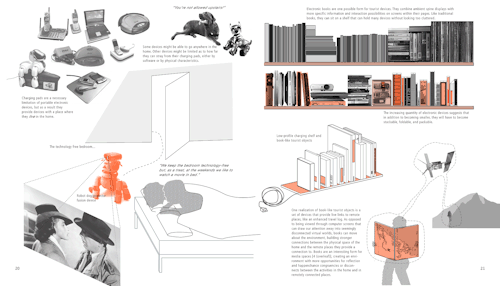
“The heterogeneous home” by Ben Hooker, Ryan Aipperspach and Allison Woodruff:
We believe that the home is becoming a more homogeneous place. The environment is increasingly filled with “any time”, “anywhere” portable devices such as cellular phones, laptops, and MP3 players that blur the traditional boundary of the home that helps individuals to define themselves in relation to the world. These technological changes are compounded by cultural changes towards a 24-hour, always connected lifestyle and structural changes towards more homogenous “cookie cutter” domestic spaces. We assembled an interdisciplinary research team, including members with experience in interaction design, computer science, and anthropology, to study the increasing homogeneity of domestic space and to generate a series of design proposals for creating more heterogeneous environments. Our proposals present a range of theoretical arguments, drawn from concepts in environmental psychology, as well as provocative design sketches which led to interactive prototypes.
Why do I blog this? Because I liked the project and found the content and the documentation intriguing.
Read More
“Kentucky Route Zero: a game in five acts by cardboard computer”:
“Kentucky Route Zero is a magical realist adventure game about a secret highway in the caves beneath Kentucky and the mysterious folks who travel it. The game is developed by Cardboard Computer (Jake Elliott and Tamas Kemenczy). The soundtrack features an original electronic score by Ben Babbitt along with a suite of old hymns and bluegrass standards recorded by The Bedquilt Ramblers.”
Read More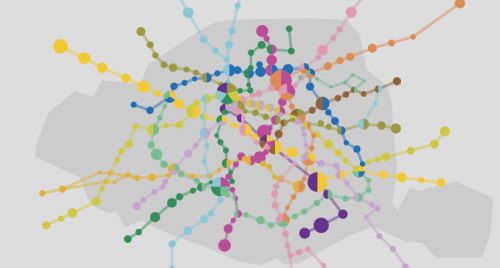
Subway usage in Paris, a data visualization made by Data-Publica with the following data.
Read More““This new law allows for testing of autonomous vehicles, or self-driving cars, by designees of an autonomous technology manufacturer, provided certain requirements are met. Prior to the public operating autonomous vehicles, a manufacturer is required to submit an application to DMV, and certify that specified insurance, vehicle safety, and testing standards have been met. The legislation authorizes regulations to specify any additional requirements deemed necessary by DMV, such as limitations on the number of autonomous vehicles deployed on the states highways, special vehicle registration and driver licensing requirements, and rules for the suspension, revocation, or denial of any license or approval issued by DMV pertaining to autonomous vehicles. (SB 1298/Padilla)””
- Why do I blog this? Being in California for the new year’s break, we had to check the new driving-related laws at the rental car office. This paragraph was quite interesting, although our rental wasn’t autonomous.
Read More






